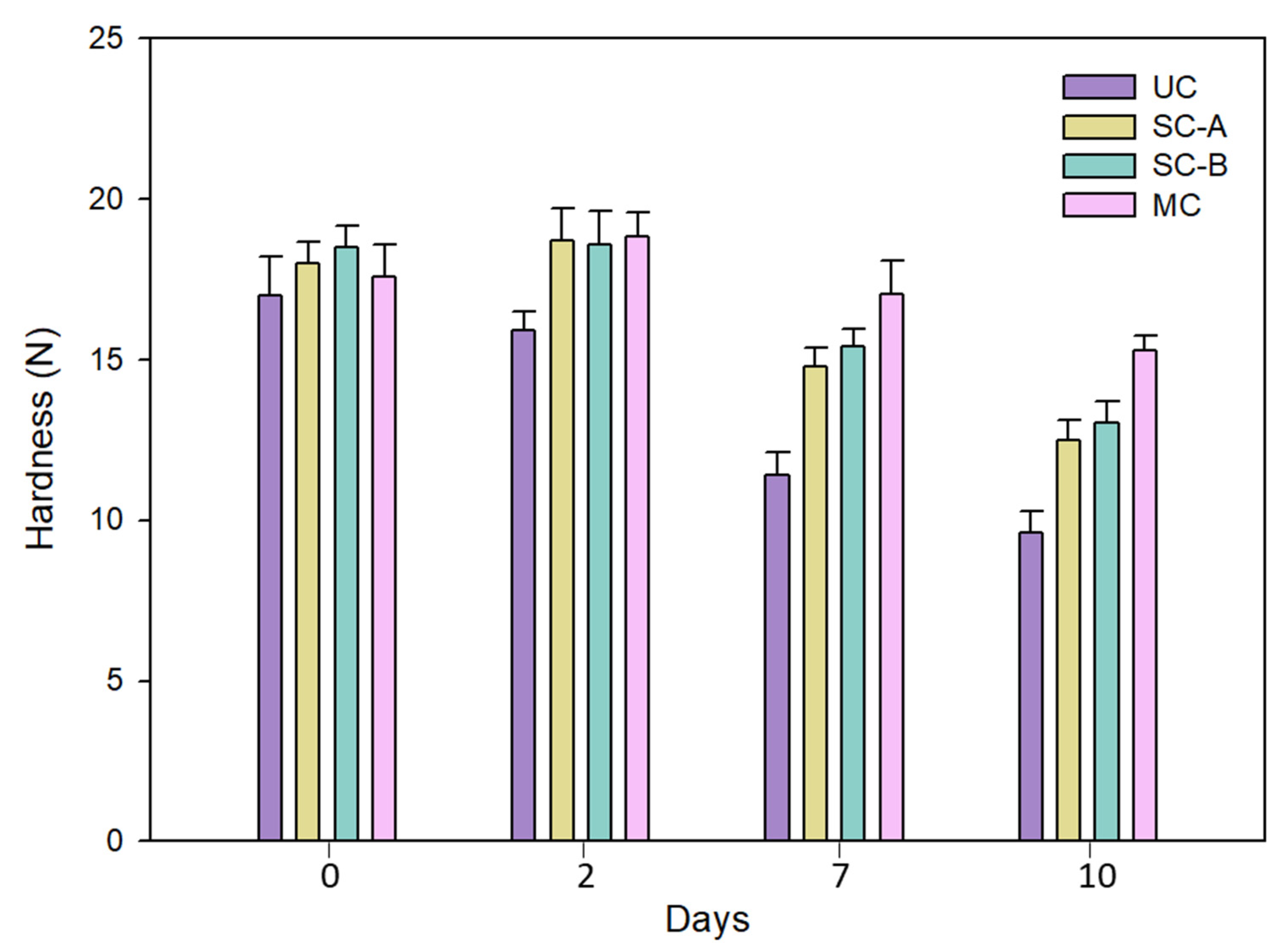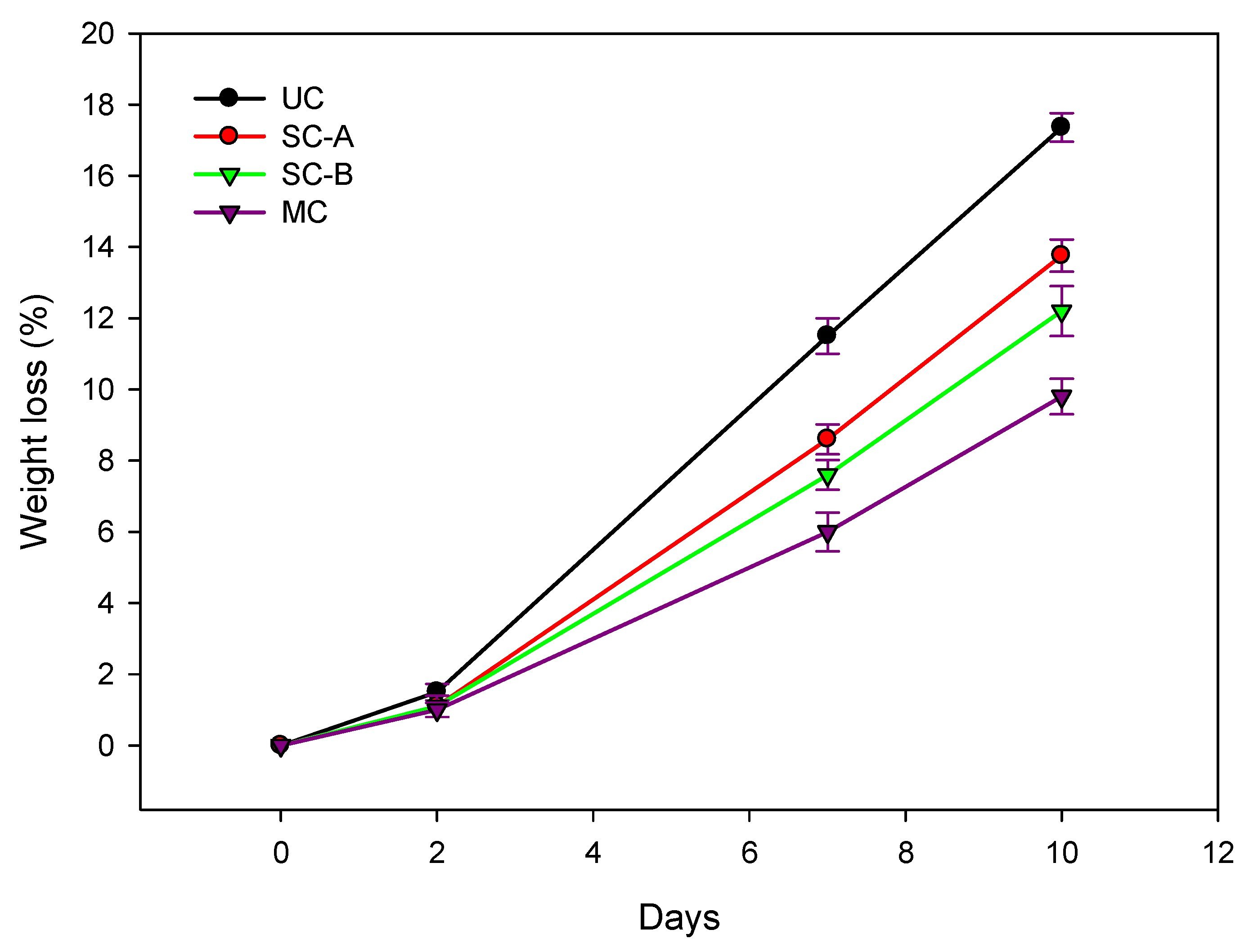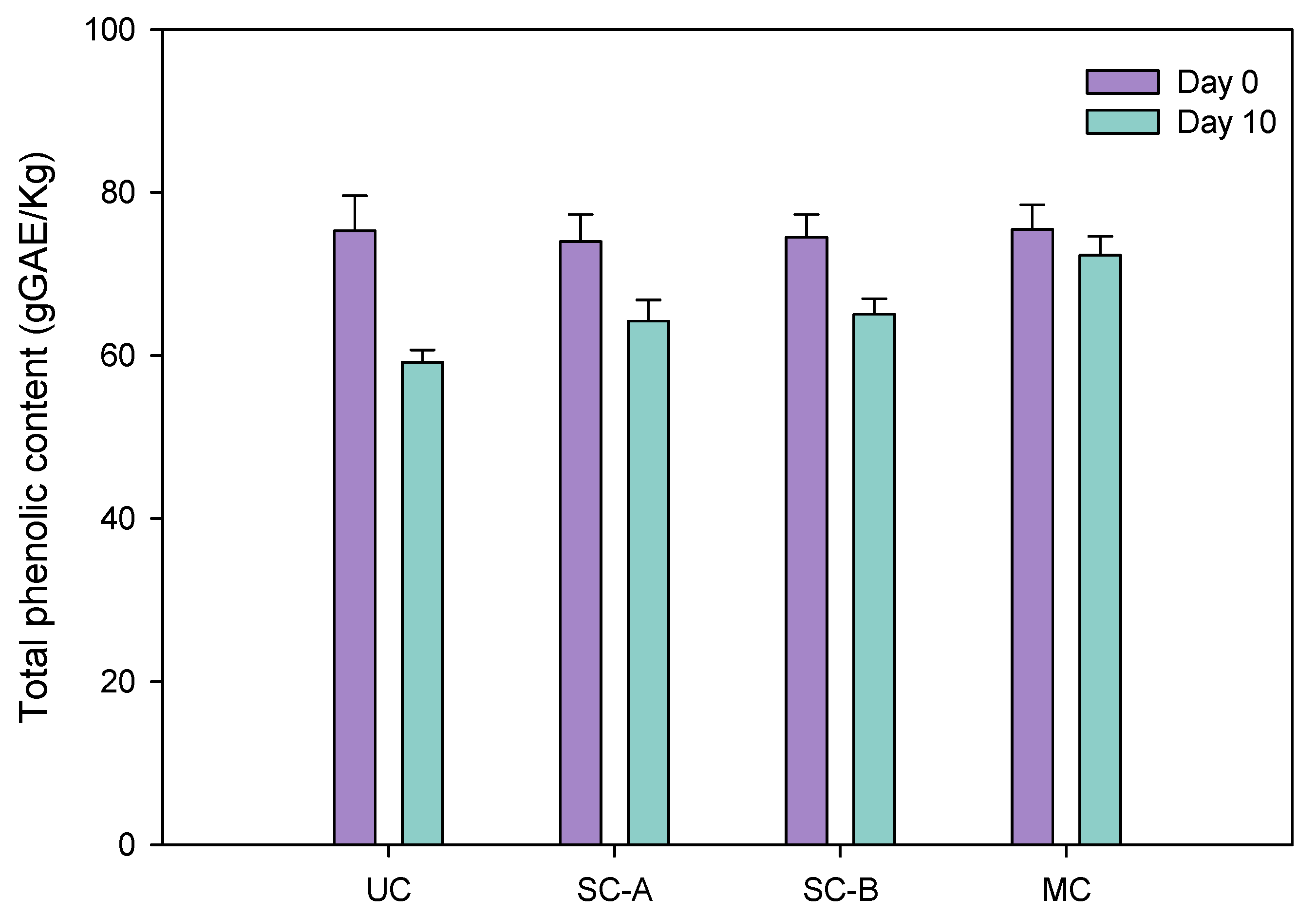Multilayered Edible Coatings to Enhance Some Quality Attributes of Ready-to-Eat Cherimoya (Annona cherimola)
Abstract
1. Introduction
2. Materials and Methods
3. Results and Discussion
3.1. Hardness (N)
3.2. Weight Loss and pH
3.3. Total Phenolic Content
3.4. Brix Percentage and Protein Content
4. Conclusions
Author Contributions
Funding
Institutional Review Board Statement
Informed Consent Statement
Data Availability Statement
Acknowledgments
Conflicts of Interest
References
- Chatrou, L.W.; Pirie, M.D.; Erkens, R.H.; Couvreur, T.L.; Neubig, K.M.; Abbott, J.R.; Mols, J.B.; Maas, J.W.; Saunders, R.M.; Chase, M.W. A new sub-familial and tribal classification of the pantropical flowering plant family Annonaceae informed by molecular phylogenetics. Bot. J. Linn. Soc. 2012, 169, 5–40. [Google Scholar] [CrossRef]
- Campos-Vargas, R.; Olmedo, P. Subtropical fruits: Cherimoyas. In Controlled and Modified Atmospheres for Fresh and Fresh-Cut Produce; Gil, M.I., Beaudry, R., Eds.; Academic Press: Cambridge, MA, USA, 2020; pp. 399–409. [Google Scholar]
- Rodríguez-Núñez, J.R.; Campos-Rojas, E.; Andrés-Agustín, J.; Alia-Tejacal, I.; Peña-Caballero, V.; Madera-Santana, T.J.; Núñez-Colín, C.A. Distribution, eco-climatic characterisation, and potential growing regions of Annona cherimola Mill. (Annonaceae) in Mexico. Ethnobiol. Conserv. 2021, 10, 1–17. [Google Scholar] [CrossRef]
- Calzada, F.; Correa-Basurto, J.; Barbosa, E.; Mendez-Luna, D.; Yepez-Mulia, L. Antiprotozoal constituents from Annona cherimola Miller, a plant used in Mexican traditional medicine for the treatment of diarrhea and dysentery. Pharmacogn. Mag. 2017, 13, 148. [Google Scholar] [PubMed]
- Coria-Téllez, A.V.; Montalvo-Gónzalez, E.; Yahia, E.M.; Obledo-Vázquez, E.N. Annona muricata: A comprehensive review on its traditional medicinal uses, phytochemicals, pharmacological activities, mechanisms of action and toxicity. Arab. J. Chem. 2018, 11, 662–691. [Google Scholar] [CrossRef]
- Hamid, R.A.; Foong, C.P.; Ahmad, Z.; Hussain, M.K. Antinociceptive and antiulcerogenic activities of the ethanolic extract of Annona muricata leaf. Rev. Bras. Farmacogn. 2012, 22, 630–641. [Google Scholar] [CrossRef]
- Konate, A.; Sawadogo, W.R.; Dubruc, F.; Caillard, O.; Ouedraogo, M.; Guissou, I.P. Phytochemical and Anticonvulsant Properties of “Annona senegalensis” Pers. (Annonaceae), Plant Used in Burkina Folk Medicine to Treat Epilepsy and Convulsions. Br. J. Pharm. Tox. 2012, 3, 245–250. [Google Scholar]
- Errayes, A.O.; Abdussalam-Mohammed, W.; Darwish, M.O. Review of phytochemical and medical applications of Annona muricata Fruits. J. Chem. Rev. 2020, 2, 70–79. [Google Scholar]
- Bhattacharya, A.; Chakraverty, R. The pharmacological properties of Annona squamosa Linn: A Review. Int. J. Pharm. Eng. 2016, 4, 692–699. [Google Scholar]
- Hernández Fuentes, L.M.; Montalvo González, E.; García Magaña, M.D.L.; Anaya Esparza, L.M.; Nolasco González, Y.; Villagrán, Z.; González Torres, S.; Velázquez Monreal, J.J.; Morelos Flores, D.A. Current Situation and Perspectives of Fruit Annonaceae in Mexico: Biological and Agronomic Importance and Bioactive Properties. Plants 2021, 11, 7. [Google Scholar] [CrossRef]
- Pareek, S.; Yahia, E.M.; Pareek, O.P.; Kaushik, R.A. Postharvest physiology and technology of Annona fruit. Food Res. Int. 2011, 44, 1741–1751. [Google Scholar] [CrossRef]
- Cordeiro, N.; Sousa, L.; Freitas, N.; Gouveia, M. Changes in the mesocarp of Annona cherimola Mill. ‘Madeira’ during postharvest ripening. Postharvest Biol. Technol. 2013, 85, 179–184. [Google Scholar] [CrossRef]
- Dhall, R.K. Advances in Edible Coatings for Fresh Fruits and Vegetables: A Review. Crit. Rev. Food Sci. Nutr. 2013, 53, 435–450. [Google Scholar] [CrossRef] [PubMed]
- Rossi-Marquez, G.; Di Pierro, P.; Mariniello, L.; Esposito, M.; Giosafatto, C.V.; Porta, R. Fresh-cut fruit and vegetable coatings by transglutaminase-crosslinked whey protein/pectin edible films. LWT 2017, 75, 124–130. [Google Scholar] [CrossRef]
- Karagöz, Ş.; Demirdöven, A. Effect of chitosan coatings with and without Stevia rebaudiana and modified atmosphere packaging on quality of cold stored fresh-cut apples. LWT 2019, 108, 332–337. [Google Scholar] [CrossRef]
- Nayak, S.L.; Sethi, S.; Sharma, R.R.; Prajapati, U. Active Edible Coatings for Fresh Fruits and Vegetables. In Polymers for Agri-Food Applications; Gutiérrez, T.J., Ed.; Springer: Cham, Switzerland, 2019; pp. 417–432. [Google Scholar]
- Perez-Gago, M.B.; Serra, M.; del Río, M.A. Color change of fresh-cut apples coated with whey protein concentrate-based edible coatings. Postharvest Biol. Technol. 2006, 39, 84–92. [Google Scholar] [CrossRef]
- Soazo, M.; Pérez, L.M.; Rubiolo, A.C.; Verdini, R.A. Pre-freezing application of whey protein-based edible coating to maintain quality attributes of strawberries. Int. J. Food Sci. Technol. 2015, 50, 605–611. [Google Scholar] [CrossRef]
- Zhang, L.; Chen, F.; Lai, S.; Wang, H.; Yang, H. Impact of soybean protein isolate-chitosan edible coating on the softening of apricot fruit during storage. LWT 2018, 96, 604–611. [Google Scholar] [CrossRef]
- Moalemiyan, M.; Ramaswamy, H.S.; Maftoonazad, N. Pectin-based edible coating for shelf-life extension of Ataulfo mango. J. Food Process Eng. 2012, 35, 572–600. [Google Scholar] [CrossRef]
- Aghaei, K.; Ghajarbeygi, P. The Effect of Edible Chitosan Coatings with Cinnamon Essential Oil on the Shelf Life of Strawberry. Doctoral Dissertation, Gazvin University of Medical Sciences, Gazvin, Iran, 2019. Available online: http://eprints.qums.ac.ir/8730/ (accessed on 20 September 2022).
- Araújo, J.M.S.; de Siqueira, A.C.P.; Blank, A.F.; Narain, N.; de Aquino Santana, L.C.L. A cassava starch–chitosan edible coating enriched with Lippia sidoides Cham. essential oil and pomegranate peel extract for preservation of italian tomatoes (Lycopersicon esculentum Mill.) stored at room temperature. Food Bioprocess Technol. 2018, 11, 1750–1760. [Google Scholar] [CrossRef]
- Minh, N.P.; Vo, T.T.; Dung, H.T.B.; Ngoc, T.T.B.; Duong, L.C.; Nghi, T.T.T. Preservation of Jackfruit Bulb by Transglutaminase Crosslinked Whey Protein/Pectin As Edible Film Coating. J. Pharmaceut. Sci. Res. 2019, 11, 1401–1405. [Google Scholar]
- Shiekh, R.A.; Malik, M.A.; Al-Thabaiti, S.A.; Shiekh, M.A. Chitosan as a novel edible coating for fresh fruits. Food Sci. Technol. Res. 2013, 19, 139–155. [Google Scholar] [CrossRef]
- Abedi, A.; Lakzadeh, L.; Amouheydari, M. Effect of an edible coating composed of whey protein concentrate and rosemary essential oil on the shelf life of fresh spinach. J. Food Process. Preserv. 2021, 45, e15284. [Google Scholar] [CrossRef]
- Nicolau-Lapena, I.; Colas-Meda, P.; Alegre, I.; Aguilo-Aguayo, I.; Muranyi, P.; Vinas, I. Aloe vera gel: An update on its use as a functional edible coating to preserve fruits and vegetables. Prog. Org. Coat. 2021, 151, 106007. [Google Scholar] [CrossRef]
- Mantilla, N.; Castell-Perez, M.E.; Gomes, C.; Moreira, R.G. Multilayered antimicrobial edible coating and its effect on quality and shelf-life of fresh-cut pineapple (Ananas comosus). LWT-Food Sci. Technol. 2013, 51, 37–43. [Google Scholar] [CrossRef]
- Sipahi, R.E.; Castell-Perez, M.E.; Moreira, R.G.; Gomes, C.; Castillo, A. Improved multilayered antimicrobial alginate-based edible coating extends the shelf life of fresh-cut watermelon (Citrullus lanatus). LWT 2013, 51, 9–15. [Google Scholar] [CrossRef]
- Zhang, W.; Shu, C.; Chen, Q.; Cao, J.; Jiang, W. The multi-layer film system improved the release and retention properties of cinnamon essential oil and its application as coating in inhibition to penicillium expansion of apple fruit. Food Chem. 2019, 299, 125109. [Google Scholar] [CrossRef]
- Liu, K.; Liu, J.; Li, H.; Yuan, C.; Zhong, J.; Chen, Y. Influence of postharvest citric acid and chitosan coating treatment on ripening attributes and expression of cell wall related genes in cherimoya (Annona cherimola Mill.) fruit. Sci. Hortic. 2016, 198, 1–11. [Google Scholar] [CrossRef]
- Anukiruthika, T.; Sethupathy, P.; Wilson, A.; Kashampur, K.; Moses, J.A.; Anandharamakrishnan, C. Multilayer packaging: Advances in preparation techniques and emerging food applications. Comp. Rev. Food Sci. Food Saf. 2020, 19, 1156–1186. [Google Scholar] [CrossRef]
- Meyers, M.A.; Chen, P.Y.; Lin, A.Y.M.; Seki, Y. Biological materials: Structure and mechanical properties. Prog. Mater. Sci. 2008, 53, 1–206. [Google Scholar] [CrossRef]
- Wang, Q.; Chen, W.; Zhu, W.; McClements, D.J.; Liu, X.; Liu, F. A review of multilayer and composite films and coatings for active biodegradable packaging. NPJ Sci. Food 2022, 6, 1–16. [Google Scholar] [CrossRef]
- Arnon, H.; Granit, R.; Porat, R.; Poverenov, E. Development of polysaccharides-based edible coatings for citrus fruits: A layer-by-layer approach. Food Chem. 2015, 166, 465–472. [Google Scholar] [CrossRef] [PubMed]
- Martiñon, M.E.; Moreira, R.G.; Castell-Perez, M.E.; Gomes, C. Development of a multilayered antimicrobial edible coating for shelf-life extension of fresh-cut cantaloupe (Cucumis melo L.) stored at 4 C. LWT-Food Sci. Technol. 2014, 56, 341–350. [Google Scholar] [CrossRef]
- Treviño-Garza, M.Z.; García, S.; Heredia, N.; Alanís-Guzmán, M.G.; Arévalo-Niño, K. Layer-by-layer edible coatings based on mucilages, pullulan and chitosan and its effect on quality and preservation of fresh-cut pineapple (Ananas comosus). Postharvest Biol. Technol. 2017, 128, 63–75. [Google Scholar] [CrossRef]
- Kandasamy, S.; Yoo, J.; Yun, J.; Kang, H.B.; Seol, K.H.; Kim, H.W.; Ham, J.S. Application of whey protein-based edible films and coatings in food industries: An updated overview. Coatings 2021, 11, 1056. [Google Scholar] [CrossRef]
- Rossi-Márquez, G.; Helguera, M.; Briones, M.; Dávalos-Saucedo, C.A.; Di Pierro, P. Edible coating from enzymatically reticulated whey protein-pectin to improve shelf life of roasted peanuts. Coatings 2021, 11, 329. [Google Scholar] [CrossRef]
- Moreira, M.D.R.; Roura, S.I.; Ponce, A. Effectiveness of chitosan edible coatings to improve microbiological and sensory quality of fresh cut broccoli. LWT-Food Sci. Technol. 2011, 44, 2335–2341. [Google Scholar] [CrossRef]
- AOAC Method 981. 12. In Official Methods of Analysis of AOAC International, 16 ed.; AOAC: Rockville, MD, USA, 1996.
- Rocha, A.M.C.N.; Morais, A.M.B.B. Polyphenoloxidase activity and total phenolic content as related to browning of minimally processed ‘Jonagored’ apple. J. Sci. Food Agric. 2002, 82, 120–126. [Google Scholar] [CrossRef]
- Lamikanra, O. Fresh-Cut Fruits and Vegetables: Science, Technology, and Market; CRC Press: Boca Ratón, FL, USA, 2002; pp. 12–19. [Google Scholar]
- Allanigue, D.K.A.; Sabularse, V.C.; Hernandez, H.P.; Serrano, E.P. The effect of chitosan-based nanocomposite coating on the postharvest life of papaya (Carica papaya L.) fruits. Philipp. Agric. Sci. 2017, 100, 233–242. [Google Scholar]
- Yin, C.; Huang, C.; Wang, J.; Liu, Y.; Lu, P.; Huang, L. Effect of chitosan- and alginate-based coatings enriched with cinnamon essential oil microcapsules to improve the postharvest quality of mangoes. Materials 2019, 12, 2039. [Google Scholar] [CrossRef]
- Zhang, L.; Huang, C.; Zhao, H. Application of pullulan and chitosan multilayer coatings in fresh papayas. Coatings 2019, 9, 745. [Google Scholar] [CrossRef]
- Zhang, W.; Zhao, H.; Zhang, J.; Sheng, Z.; Cao, J.; Jiang, W. Different molecular weights chitosan coatings delay the senescence of postharvest nectarine fruit in relation to changes of redox state and respiratory pathway metabolism. Food Chem. 2019, 289, 160–168. [Google Scholar] [CrossRef] [PubMed]
- Yonemoto, Y.; Higuchi, H.; Kitano, Y. Effects of storage temperature and wax coating on ethylene production, respiration, and shelf-life in cherimoya fruit. J. Jpn. Soc. Hortic. Sci. 2002, 71, 643–650. [Google Scholar] [CrossRef]
- Paull, R.E.; Deputy, J.; Chen, N.J. Changes in organic acids, sugars, and headspace volatiles during fruit ripening of soursop (Annona muricata L.). J. Am. Soc. Hortic. Sci. 1983, 108, 931–934. [Google Scholar] [CrossRef]
- Gutiérrez, M.; Lahoz, J.M.; Sola, M.; Pascual, L.; Vargas, A.M. Postharvest changes in total soluble solids and tissue pH of cherimoya fruit stored at chilling and non-chilling temperatures. J. Hortic. Sci. 1994, 69, 459–463. [Google Scholar] [CrossRef]
- Jiménez-Moreno, N.; Esparza, I.; Bimbela, F.; Gandía, L.M.; Ancín-Azpilicueta, C. Valorization of selected fruit and vegetable wastes as bioactive compounds: Opportunities and challenges. Crit. Rev. Environ. Sci. Technol. 2020, 50, 2061–2108. [Google Scholar] [CrossRef]
- Quero, J.; Mármol, I.; Cerrada, E.; Rodríguez-Yoldi, M.J. Insight into the potential application of polyphenol-rich dietary intervention in degenerative disease management. Food Funct. 2020, 11, 2805–2825. [Google Scholar] [CrossRef]
- Mármol, I.; Quero, J.; Ibarz, R.; Ferreira-Santos, P.; Teixeira, J.A.; Rocha, C.M.R.; Pérez-Fernández, M.; García-Juiz, S.; Osada, J.; Martín-Belloso, O.; et al. Valorization of agro-food by-products and their potential therapeutic applications. Food Bioprod. Process. 2021, 128, 247–258. [Google Scholar] [CrossRef]
- Kerch, G. Chitosan films and coatings prevent losses of fresh fruit nutritional quality: A review. Trends Food Sci. Technol 2015, 46, 159–166. [Google Scholar] [CrossRef]
- Li, H.; Shui, Y.; Li, S.; Xing, Y.; Xu, Q.; Li, X.; Lin, H.; Wang, Q.; Yang, H.; Li, W.; et al. Quality of fresh cut lemon during different temperature as affected by chitosan coating with clove oil. Int. J. Food Prop. 2020, 23, 1214–1230. [Google Scholar] [CrossRef]
- Merodio, C.; De La Plaza, J.L. Cherimoya. In Postharvest Physiology and Storage of Tropical and Subtropical Fruits; Mitra, S.K., Ed.; CAB International: Boston, MA, USA, 1997; pp. 269–293. [Google Scholar]
- Palma, T.; Aguilera, J.M.; Stanley, D.W. A review of postharvest events in cherimoya. Postharvest Biol. Technol. 1993, 2, 187–208. [Google Scholar] [CrossRef]





| Samples | Days | |||||||
|---|---|---|---|---|---|---|---|---|
| 0 | 2 | 7 | 10 | |||||
| Prot. | Brix | Prot. | Brix | Prot. | Brix | Prot. | Brix | |
| UC | 1.42 ± 0.21 | 23.2 ± 1.2 | 1.03 ± 0.13 | 25.3 ± 0.9 | 0.77 ± 0.1 | 28.5 ± 1.2 | 0.54 ± 0.06 | 30.9 ± 1.2 |
| SC-A | 1.44 ± 0.11 | 22.7 ± 1.4 | 1.35 ± 0.32 | 23.8 ± 1.2 | 0.85 ± 0.2 | 26.2± 1.0 | 0.73 ± 0.05 | 28.7 ± 0.9 |
| SC-B | 1.38 ± 0.11 | 23.6 ± 1.1 | 1.25 ± 0.12 | 24.5 ± 1.2 | 0.85 ± 0.2 | 25.2 ± 1.2 | 0.81 ± 0.2 | 27.4 ± 1.2 |
| MC | 1.42 ± 0.23 | 23.1 ± 1.5 | 1.32 ± 0.38 | 24.1 ± 1.3 | 1.16 ± 0.09 | 25.1 ± 1.5 | 0.94 ± 0.04 | 26.23± 1.2 |
Disclaimer/Publisher’s Note: The statements, opinions and data contained in all publications are solely those of the individual author(s) and contributor(s) and not of MDPI and/or the editor(s). MDPI and/or the editor(s) disclaim responsibility for any injury to people or property resulting from any ideas, methods, instructions or products referred to in the content. |
© 2022 by the authors. Licensee MDPI, Basel, Switzerland. This article is an open access article distributed under the terms and conditions of the Creative Commons Attribution (CC BY) license (https://creativecommons.org/licenses/by/4.0/).
Share and Cite
Rossi-Márquez, G.; Dávalos-Saucedo, C.A.; Mayek-Pérez, N.; Di Pierro, P. Multilayered Edible Coatings to Enhance Some Quality Attributes of Ready-to-Eat Cherimoya (Annona cherimola). Coatings 2023, 13, 41. https://doi.org/10.3390/coatings13010041
Rossi-Márquez G, Dávalos-Saucedo CA, Mayek-Pérez N, Di Pierro P. Multilayered Edible Coatings to Enhance Some Quality Attributes of Ready-to-Eat Cherimoya (Annona cherimola). Coatings. 2023; 13(1):41. https://doi.org/10.3390/coatings13010041
Chicago/Turabian StyleRossi-Márquez, Giovanna, Cristian Aarón Dávalos-Saucedo, Netzahualcóyotl Mayek-Pérez, and Prospero Di Pierro. 2023. "Multilayered Edible Coatings to Enhance Some Quality Attributes of Ready-to-Eat Cherimoya (Annona cherimola)" Coatings 13, no. 1: 41. https://doi.org/10.3390/coatings13010041
APA StyleRossi-Márquez, G., Dávalos-Saucedo, C. A., Mayek-Pérez, N., & Di Pierro, P. (2023). Multilayered Edible Coatings to Enhance Some Quality Attributes of Ready-to-Eat Cherimoya (Annona cherimola). Coatings, 13(1), 41. https://doi.org/10.3390/coatings13010041










